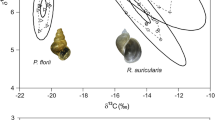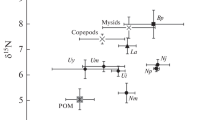Abstract
The goals of this study were to analyze if there is a difference in the stable isotopic ratio (δ13C and δ15N) of macrobenthic species sampled at two sandy beaches (one close to a river mouth and the other far from any freshwater input) and to identify differences in the stable isotopic ratio (δ13C and δ15N) in different body parts of three representative species of two Brazilian sandy beach macrofaunas: the polychaete Hemipodia californiensis, the mollusk bivalve Donax hanleyanus, and the crustacean decapod Emerita brasiliensis. No significant differences were detected in the δ13C stable isotopic ratio between the two sites analyzed; however, in the δ15N stable isotopic ratio, a significant difference was observed. Regarding the intraspecific response of stable isotopic ratio, D. hanleyanus showed a significant difference in carbon among different body part structures, while a trend for significance was observed for nitrogen isotopes. The differences were significant for both isotopes in E. brasiliensis, and no differences were observed among the body part structures in H. californiensis. There were significant differences in E. brasiliensis carapaces with regard to the δ15N stable isotopic ratio between the muscle and the whole body. Although the δ13C and δ15N stable isotopic ratio differs significantly in the digestive tract, muscles, and whole body of D. hanleyanus, such differences were not enough to determine changes in their trophic levels and food sources. Similar stable isotopic ratios were observed in the whole body, proboscis, and teeth of H. californiensis, highlighting this species as the top predator. In conclusion, stable isotopic analysis of benthic trophic structure can be employed as a tool in coastal management plans or environmental impact studies.
Similar content being viewed by others
References
Antonio ES, Kasai A, Ueno M, Kurikawa Y, Tsuchiya K, Toyohara H, Ishihi Y, Yokoyama H, Yamashita Y (2010) Consumption of terrestrial organic matter by estuarine molluscs determined by analyses of their stable isotopes and cellulase activity. Estuar Coast Shelf Sci 86:401–407
Bergamino L, Lercari D, Defeo O (2011) Food web structure of sandy beaches: temporal and spatial variation using stable isotope analyses. Estuar Coast Shelf Sci 91:536–543
Bongiorni L, Fiorentino F, Auriemma R, Aubry FB, Camatti E, Camin F, Nasi F, Pansera M, Ziller L, Grall J (2016) Food web of a confined and anthropogenically affected coastal basin (the Mar Piccolo of Taranto) revealed by carbon and nitrogen stable isotopes analyses. Environ Sci Pollut Res 23:2725–12738
Carreira RS, Cordeiro LGMS, Oliveira DRP, Baêta A, Wagener ALR (2015) Source and distribution of organic matter in sediments in the SE Brazilian continental shelf influenced by river discharges: an approach using stable isotopes and molecular markers. J Mar Syst 141:80–89
Corbisier TN, Soares LSH, Petti MAV, Muto EY, Silva MHC, McClelland J, Valiela I (2006) Use of isotopic signatures to assess the food web in a tropical shallow marine ecosystem of Southeastern Brazil. Aquat Ecol 40:381–390
Corbisier TN, Petti MAV, Soares LS, Muto EY, Bromberg S, Valiela I (2014) Trophic structure of benthic communities in the Cabo Frio upwelling system (southeastern Brazilian shelf): a temporal study using stable isotope analyses. Mar Ecol Prog Ser 512:23–38
Cordeiro LGMS, Wagener ALR, Carreira RS (2018) Organic matter in sediments of a tropical and upwelling influenced region of the Brazilian continental margin (Campos Basin, Rio de Janeiro). Org Geochem 120:86–98
Di Beneditto APM, Rezende CE, Camargo PB, Kehrig HA (2013) Trophic niche comparison between two predators in northern Rio de Janeiro State, Brazil: a stable isotopes approach. Biota Neotrop 13:29–33
Estes L, Elsen PR, Treuer T, Ahmed L, Caylor K, Chang J, Choi JJ, Ellis E (2018) The spatial and temporal domains of modern ecology. Nat Ecol Evol 2:819–826. https://doi.org/10.1038/s41559-018-0524-4
Fauchald K, Jumars PA (1979) The diet of worms: a study of polychaete feeding guilds. Oceanogr Mar Biol 17:193–284
France RL (1994) Nitrogen isotopic composition of marine and freshwater invertebrates. Mar Ecol Prog Ser 115:205–207
Franco MAL (2013) Uso de ferramentas múltiplas na investigação do impacto de um recife artificial sobre uma assembleia de peixes transientes no norte do estado do Rio de Janeiro. Doctoral dissertation Thesis, North Rio de Janeiro University, RJ, Brazil
Fry B (2006) Stable isotope ecology. Springer, New York
Fry B, Mumford PL, Tam F, Fox DD, Warren GL, Havens KE, Steinman AD (1999) Trophic position and individual feeding histories of fish from Lake Okeechobee, Florida. Can J Fish Aquat Sci 56:590–600
Gustafson L, Showers W, Kwak T, Levine J, Stoskopf M (2007) Temporal and spatial variability in stable isotope compositions of a freshwater mussel: implications for biomonitoring and ecological studies. Oecologia 152:140–150
Han E, Park HJ, Bergamino L, Choi KS, Choy EJ, Yu OH, Kang CK (2015) Stable isotope analyses of a newly established macrofaunal food web 1.5 years after the Hebei Spirit oil spill. Mar Pollut Bull 90:167–180
Kiljunen M, Grey J, Sinisalo T, Harrod C, Immonen H, Jones RI (2006) A revised model for lipid-normalizing δ13C values from aquatic organisms, with implications for isotope mixing models. J Appl Ecol 43:1213–1222
Kogure Y (2004) Stable carbon and nitrogen isotope analyses of the sublittoral benthic food web structure of an exposed sandy beach. Bul Biogeog Soc Jpn 59:15–25
Krüger GCT, de Carvalho CEV, Suzuki MS (2006) Dissolved nutrient, chlorophyll-a and DOC dynamic under distinct riverine discharges and tidal cycles regimes at the Paraiba do Sul River estuary, RJ, Brazil. J Coast Res 39:724–730
Levin AS (1992) The problem of pattern and scale in ecology. Ecology 73:1943–1967
Liao E, Lu W, Yan X-H, Jiang Y, Kidwell A (2015) The coastal ocean response to the global warming acceleration and hiatus. Sci Rep 5:16630. https://doi.org/10.1038/srep16630
Manetta G, Benedito-Cecilio E (2003) Aplicação da técnica de isótopos estáveis na estimativa da taxa de turnover em estudos ecológicos: uma síntese. Acta Sci Biol Sci 25:121–129
Mateo MA, Serrano O, Serrano L, Michener RH (2008) Effects of sample preparation on stable isotope ratio of carbon and nitrogen in marine invertebrates: implications for food web studies using stable isotopes. Oecologia 157:105–115
McLachlan A, Brown AC (2006) Ecology of sandy shores. Academic, New York
Michener R, Lajtha K (2008) Stable isotopes in ecology and environmental science, 2nd edn. Blackwell Publishing Ltd, Oxford
Olsen YS, Fox SE, Hofmann L, Valiela I (2013) Benthic community composition and faunal stable isotopic signatures differ across small spatial scales in a temperate estuary. Mar Environ Res 86:12–20
Peterson BJ, Fry B (1987) Stable isotopes in ecosystem studies. Annu Ver Ecol Syst 18:293–320
Petracco M (2008) Produção secundária da macrofauna bentônica da zona entremarés no segmento norte da praia do Una, litoral sul do Estado de São Paulo. Tese de Doutorado, Instituto Oceanográfico, Universidade de São Paulo, 236p
Pinotti RM, Minasi DM, Colling LA, Bemvenuti CE (2014) A review on macrobenthic trophic relationships along subtropical sandy shores in southernmost Brazil. Biota Neotrop 14(3):e20140069
Post DM (2002) Using stable isotopes to estimate trophic position: models, methods, and assumptions. Ecology 83:703–718
Post DM, Layman CA, Arrington DA, Takimoto G, Quattrochi J, Montaña CG (2007) Getting to the fat of the matter: models, methods and assumptions for dealing with lipids in stable isotope analyses. Oecologia 152:179–189
Thrush SF, Hewitt JE, Gibbs M, Lundquist C, Norkko A (2006) Functional role of large organisms in intertidal communities: community effects and ecosystem function. Ecosystems 9:1029–1040
Underwood AJ (1997) Experiments in ecology: their logical design and interpretation using analyses of variance. Cambridge University Press, Cambridge
UNEP (2002) Oceans and coastal areas. Coastal threats [online] Cited November 2004. Available at http://earthwatch.unep.net/oceans/coastalthreats.php
van der Linden PRA (2017) A trait-based approach to investigate macrobenthic community functioning in estuarine and coastal ecosystems. Universidade de Coimbra. Tese de doutoramento. Available at http://hdl.handle.net/10316/79651. 18 Oct 2018
Yokoyama H, Tamaki A, Harada K, Shimoda K, Koyama K, Ishihi Y (2005) Variability of diet-tissue isotopic fractionation in estuarine macrobenthos. Mar Ecol Prog Ser 296:115–128
Funding
This study received financial support from the Universidade Estadual do Norte Fluminense (Brazil). T.C.M. Almeida received grants from Brazilian agencies FAPERJ (no. 102.004/2013) and CNPq (no. 158504/2014-3).
Author information
Authors and Affiliations
Corresponding authors
Additional information
Responsible editor: Philippe Garrigues
Publisher’s note
Springer Nature remains neutral with regard to jurisdictional claims in published maps and institutional affiliations.
Rights and permissions
About this article
Cite this article
Almeida, T.C.M., Rocha, P.F.P., Zalmon, I.R. et al. Is there an indication of the origin of nutrient supply in different morphological structures of macrofauna at two different Brazilian southeastern sandy beaches? Comparison by C and N stable isotopes. Environ Sci Pollut Res 26, 33023–33029 (2019). https://doi.org/10.1007/s11356-019-06376-4
Received:
Accepted:
Published:
Issue Date:
DOI: https://doi.org/10.1007/s11356-019-06376-4




